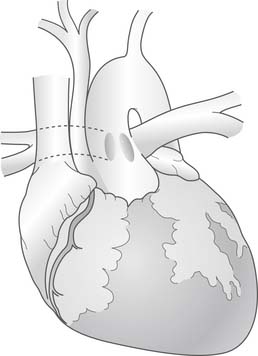
Neonates with IAA may initially have differential cyanosis secondary to right to left shunting at the duct. Neonates will require prostaglandin-E1 (PGE) administration after birth until surgical repair is performed. If not prenatally diagnosed, infants will present in the neonatal period as they have ductal dependent systemic blood flow. Typically the portion of aorta which is proximal to the site of interruption will have an unusual configuration and end at the site of interruption with the brachiocephalic vessels directed straight towards the upper body. Prenatal diagnosis is possible which can identify interruption site and vessels arising from ductal arch. Type C (<1%): Interruption occurs between the innominate (or brachiocephalic) artery and the left common carotid artery. An aberrant right subclavian artery may be seen in this type. Type B (~66%): Interruption occurs between the left common carotid artery and the left subclavian artery. Type A (~33%): Interruption occurs after the aortic isthmus, just beyond the left subclavian artery and proximal to the ductal insertion. There are three subtypes which are classified according to the site of the interruption: This is infrequently seen with type A or C. IAA type B is specifically associated with a posterior malalignment ventricular septal defect (VSD) with resultant narrowing of the left ventricular outflow tract (LVOT) and hypoplasia of the aortic valve.Īmong patients with congenital heart disease, IAA occurs ~1% of the time, with IAA type B being the most common form.Īmong patients with IAA, specifically type B, >50% have 22q11 deletion (DiGeorge syndrome). Interrupted aortic arch (IAA) is a congenital anomaly where there is interruption or discontinuation of a segment of the aortic arch. IAA is frequently associated with ventricular septal defects (VSD) and a bicuspid aortic valve. Left Ventricular Non Compaction Cardiomyopathy (LVNC).Right Aortic Arch with an Aberrant Left Subclavian Artery (Vascular Ring).Infracardiac Total Anomalous Pulmonary Venous Return.Idiopathic Infantile Arterial Calcification.Congenitally Corrected Transposition of the Great Arteries (ccTGA).Transposition of the Great Arteries (DTGA).Pulmonary Atresia with Intact Ventricular Septum (PA/IVS).Tetralogy of Fallot with Pulmonary Atresia.Tetralogy of Fallot with Absent Pulmonary Valve.

Supracardiac Total Anomalous Pulmonary Venous Return.Total Anomalous Pulmonary Venous Return to the Coronary Sinus.Pulmonary Artery Sling (Vascular Sling).Anomalous Left Coronary Artery from the Right Coronary Artery.Anomalous Right Coronary Artery from the Left Coronary Artery.Transitional Atrioventricular Canal (AV Canal).Partial Atrioventricular Canal (AV Canal).Complete Atrioventricular Canal (AV Canal).


 0 kommentar(er)
0 kommentar(er)
